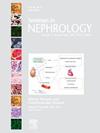Regional Citrate Anticoagulation: A Tale of More Than Two Stories
IF 2.8
3区 医学
Q2 UROLOGY & NEPHROLOGY
引用次数: 0
Abstract
Calcium is a key clotting factor, and several inorganic molecules that bind to calcium have been found to reduce the clotting propensity of blood. Citrate, a calcium chelator, is used as inhibitor of the coagulation cascade in blood transfusion. Also, it is used as an anaticoagulant during dialysis to maintain patency of the extracorporeal circuit, known as regional citrate anticoagulation (RCA). The amount of citrate should be chosen such that ionized calcium concentrations in the extracorporeal circuit are reduced enough to minimize propagation of the coagulation cascade. The dialytic removal of the calcium–citrate complexes combined with reduced ionized calcium concentrations makes necessary calcium supplementation of the blood returning to the patient. This can be achieved in different ways. In classical RCA, citrate and calcium are infused in the afferent and efferent tubing, respectively, whereas the dialysate does not contain calcium. This setup has been shown to be highly efficacious with a very low clotting propensity. Strict monitoring of blood electrolytes is required. Alternatively, the use of a high-calcium dialysate leads to calcium loading, obviating the need for a separate calcium infusion pump. The main advantages are simplified delivery of RCA and less fluctuation of systemic calcium concentrations. Currently, citric acid is sometimes added to the acid concentrate as a replacement for acetic acid. Differences and similarities between RCA and citrate-containing dialysate are discussed. RCA is an excellent alternative to heparin for patients at high risk of bleeding.
区域性枸橼酸抗凝:不只是两个故事的故事。
钙是一种关键的凝血因子,已发现几种与钙结合的无机分子可降低血液的凝结倾向。柠檬酸盐是一种钙螯合剂,在输血过程中被用作凝血级联的抑制剂。此外,它还在透析过程中用作抗凝剂,以保持体外循环的通畅,即区域性枸橼酸抗凝(RCA)。枸橼酸盐的用量应足以降低体外循环中的离子钙浓度,从而最大限度地减少凝血级联反应的传播。透析去除钙-柠檬酸盐复合物,同时降低离子钙浓度,因此有必要对患者回流的血液进行补钙。这可以通过不同的方式实现。在传统的 RCA 中,枸橼酸盐和钙分别注入传入和传出管道,而透析液中不含钙。这种设置已被证明非常有效,而且凝血倾向非常低。需要严格监测血液电解质。另外,使用高钙透析液也会导致钙负荷,从而无需单独的钙输注泵。其主要优点是简化了 RCA 的输送,减少了全身钙浓度的波动。目前,有时会在浓缩酸中添加柠檬酸,以替代醋酸。本文讨论了 RCA 和含柠檬酸的透析液之间的异同。对于出血风险高的患者来说,RCA 是肝素的绝佳替代品。Semin Nephrol 36:x-xx © 20XX Elsevier Inc.保留所有权利。
本文章由计算机程序翻译,如有差异,请以英文原文为准。
求助全文
约1分钟内获得全文
求助全文
来源期刊

Seminars in nephrology
医学-泌尿学与肾脏学
CiteScore
5.60
自引率
0.00%
发文量
27
审稿时长
6-12 weeks
期刊介绍:
Seminars in Nephrology is a timely source for the publication of new concepts and research findings relevant to the clinical practice of nephrology. Each issue is an organized compendium of practical information that serves as a lasting reference for nephrologists, internists and physicians in training.
 求助内容:
求助内容: 应助结果提醒方式:
应助结果提醒方式:


